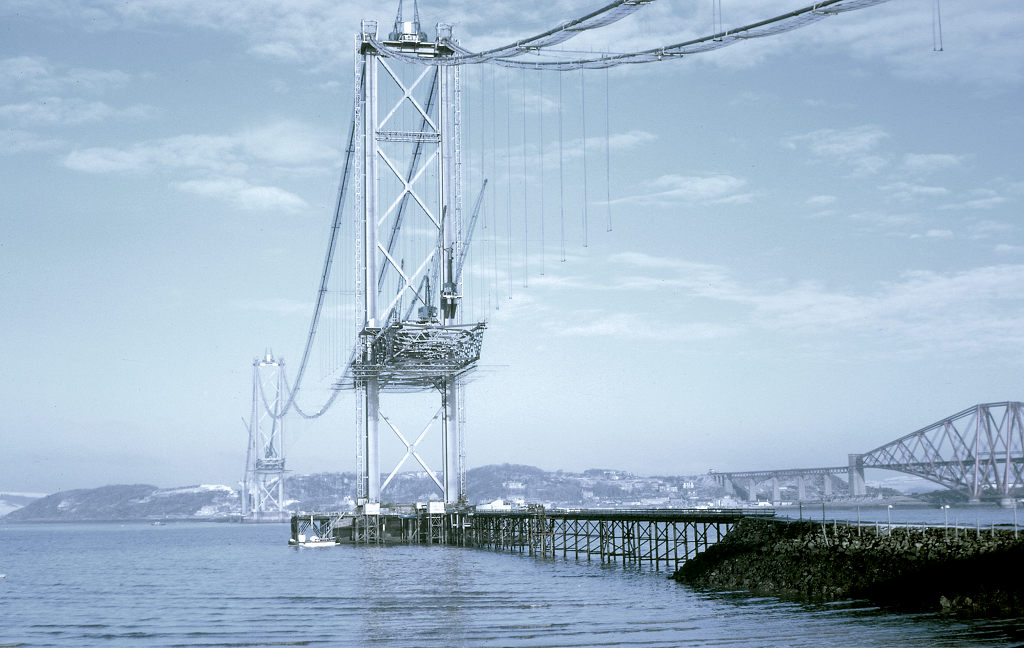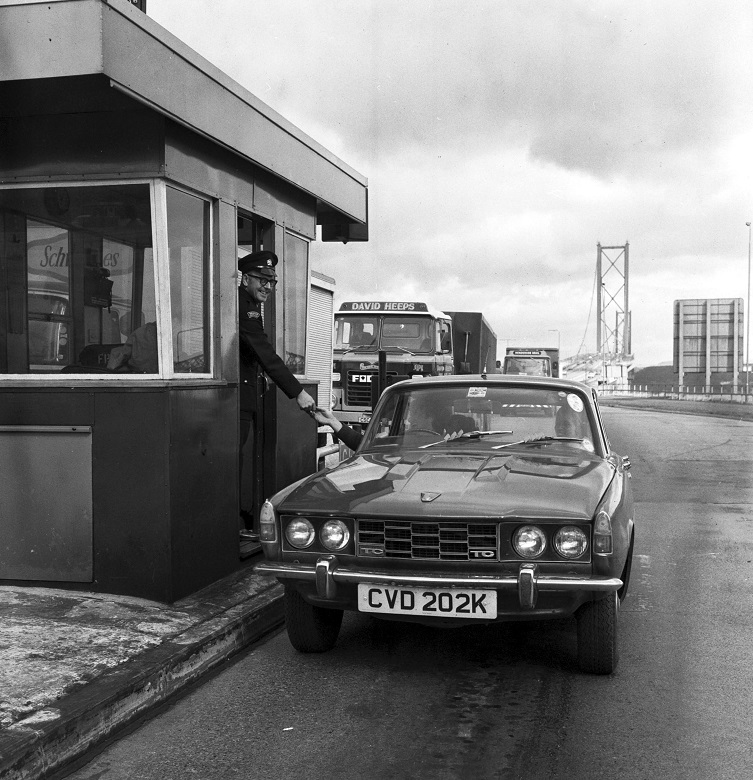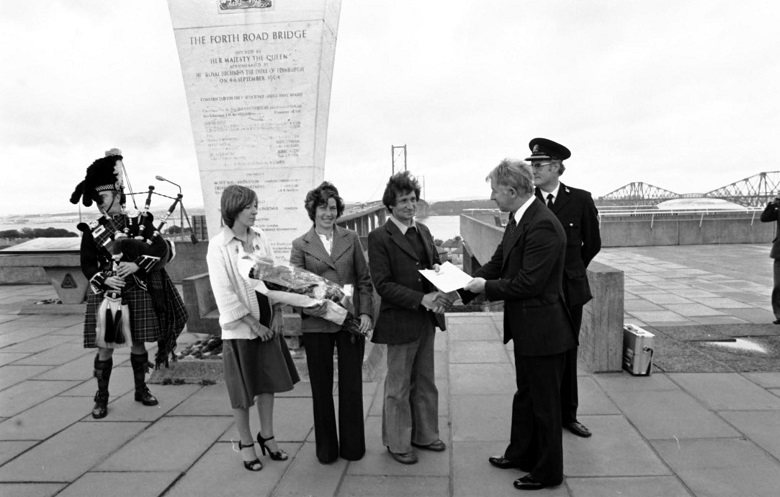The Forth Road Bridge has been carrying commuters, day trippers and holidaymakers between Edinburgh and the Kingdom of Fife for six decades.
When Queen Elizabeth II officially opened it on 4 September 1964, it was the longest bridge in Europe, and it was the fourth largest in the world. It received Category A listed status for its historical and architectural significance in 2001.
So, we’ve delved into the HES archives to celebrate the latest milestone in the story of the monumental megastructure. Happy 60th birthday, Forth Road Bridge!
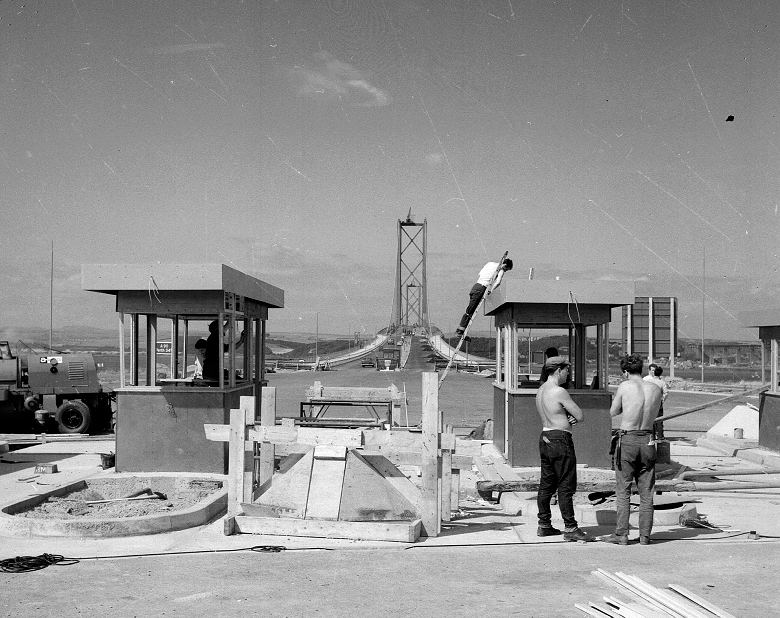
Tollbooths for the Forth Road Bridge under construction, 26 July 1960 (© The Scotsman Publications Ltd. Licensed via Scran)
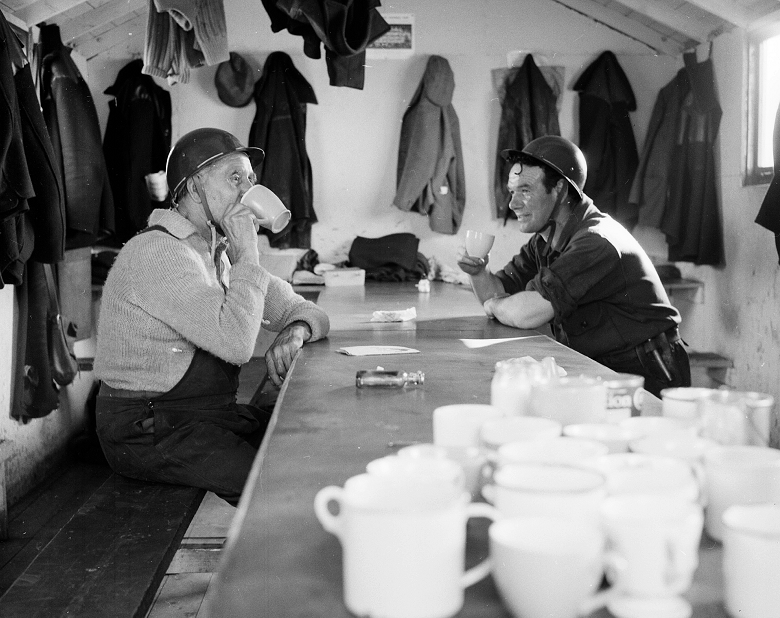
A tea break at the Forth Road Bridge construction site in September 1959 ( © The Scotsman Publications Ltd. Licensed via Scran)
A new crossing
Queen Margaret established the first crossing of the Forth between what is now North and South Queensferry way back in the 11th century. The highly influential monarch wanted to make it easier for pilgrims to reach St Andrew’s Cathedral.
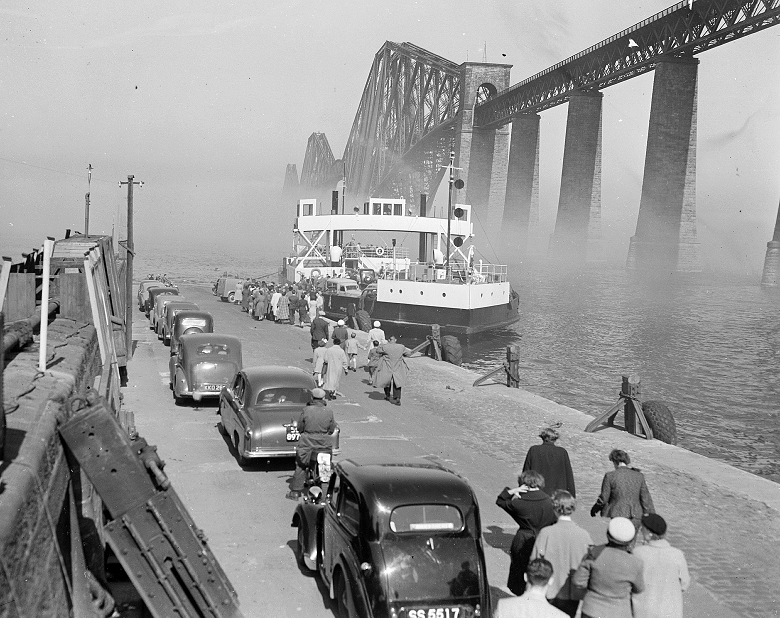
Cars queuing for the ferry across the Firth of Forth in November 1952. At this time, the ferries were carrying 1.5 million passengers and 800,000 vehicles every year. The need for a Forth Road Bridge was clear. (© The Scotsman Publications Ltd. Licensed via Scran)
Boats worked the “Queen’s Ferry” all the way up to 1964, but the idea of a bridge at the site was considered as early as in the 1740s. The opening of the Forth Bridge in 1890 proved such a project was feasible. By the 1950s, with car ownership on the rise and the ferries in constant demand, a solution was necessary.
Green Light for the Forth Road Bridge
The Forth Road Bridge Joint Board was established to investigate the options in 1947. Having abandoned early plans to build a tunnel known as the Maunsell Scheme, Europe’s longest suspension bridge was given the green light.
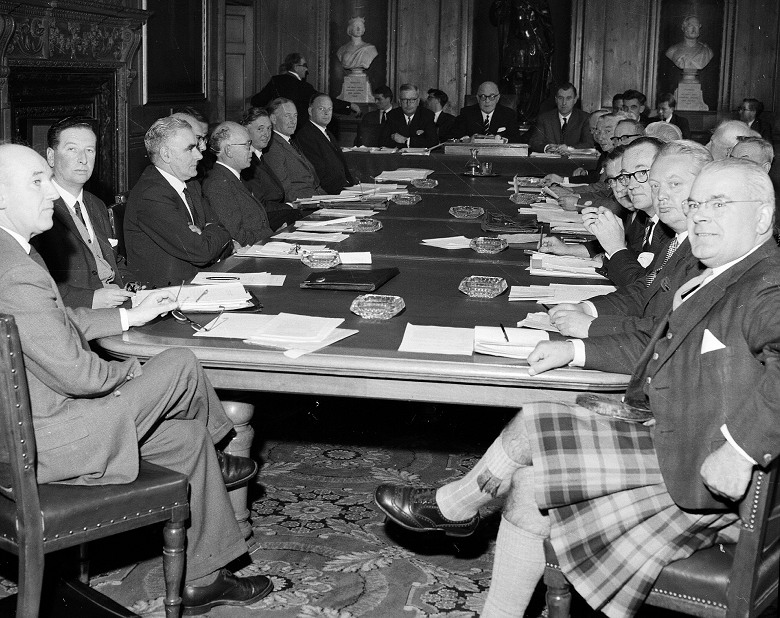
A meeting of the Forth Road Bridge Joint Board in October 1959. (© The Scotsman Publications Ltd. Licensed via Scran)
The scale of the project meant that the three largest engineering firms in Britain needed to join forces. Sir William Arrol & Company, The Cleveland Bridge & Engineering Company and Dorman Long (Bridge & Engineering) Ltd formed a consortium called the ACD Bridge Company Ltd. Work began in September 1958.
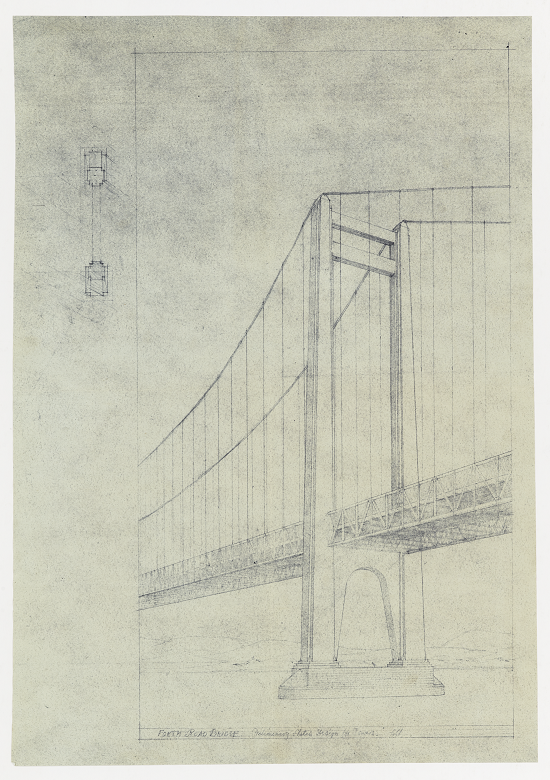
A preliminary sketch design for the towers of the Forth Road Bridge by Giles Gilbert Scott. Scott was a consulting architect on the project, but he died in 1960 and never saw the bridge completed. (© HES. Zoom in on Canmore)
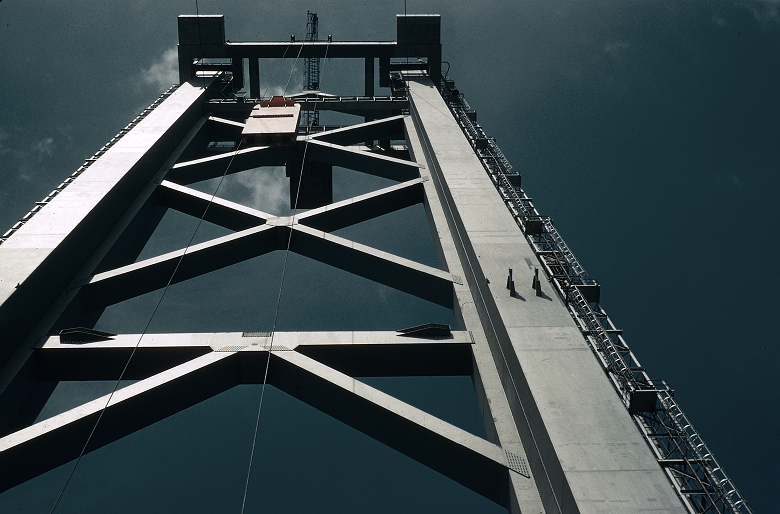
One of the Forth Road Bridge’s towers nearing completion, June 1961 (© Courtesy of HES. RB Wood Collection. Zoom in on Canmore).
Diving and Spinning
Building the new bridge was a daunting and dangerous undertaking which tragically claimed the lives of seven workers. One of the first tasks involved diving deep into the waters of the Forth to build dams, which would allow for the two enormous towers to be erected. The towers were then connected by precarious-looking walkways.
Officially, foreman Jimmy Lafferty was the first person to cross the river on foot – but two young engineers reportedly beat him to it by performing “a tightrope act down the cables.”
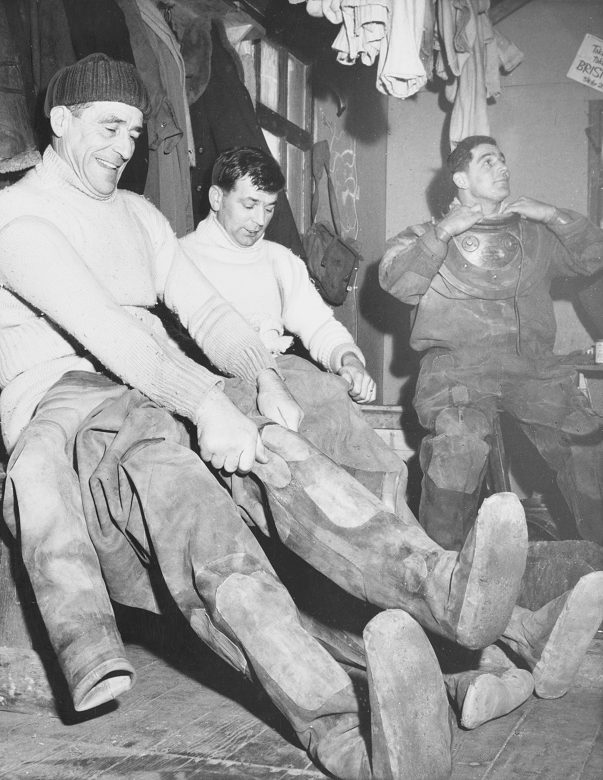
Divers getting ready for another day working on the Forth Road Bridge (© Newsquest, Herald & Times. Licensed via Scran)
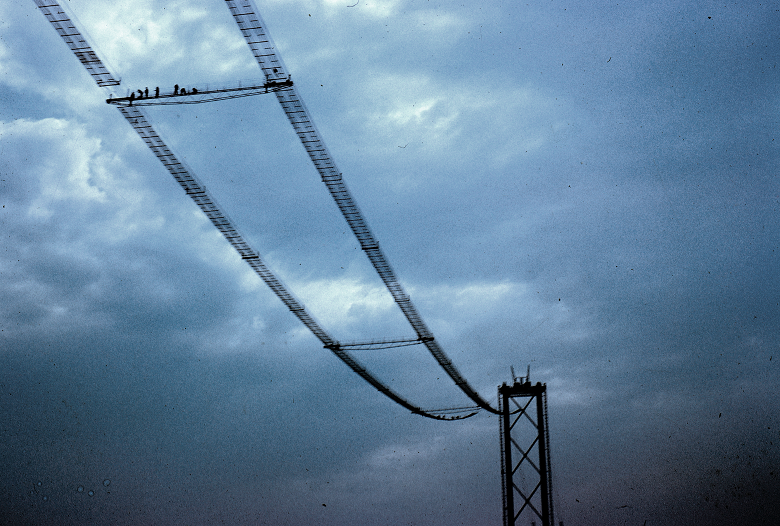
This image from 1961 shows workers on the walkways high above the Forth (© Courtesy of HES. RB Wood Collection. Zoom in on Canmore)
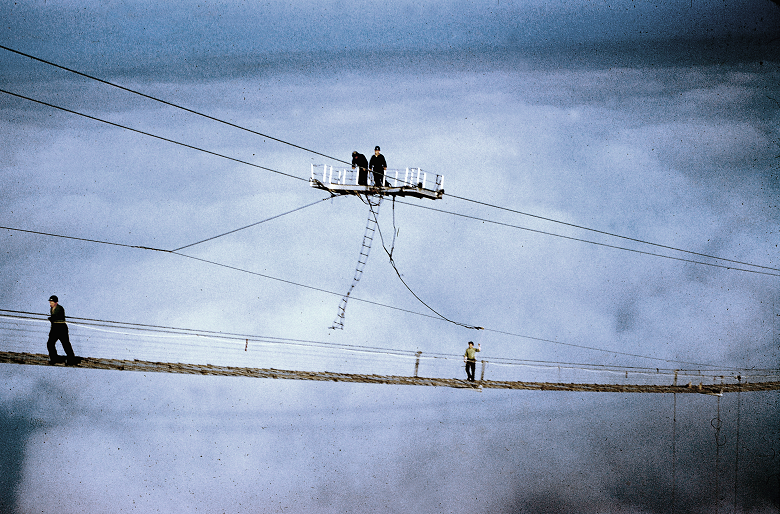
A two-man crew use a suspended work-car in October 1961 (© Courtesy of HES. RB Wood Collection. Zoom in on Canmore)
By 1962, workers had completed the task of “spinning” individual wires back and forth across the water to create the massive cables which would support the bridge. A pulley system was used to move some 30,000 miles of wire. That’s enough to go around the world 1.25 times!
The wire-spinning method hadn’t been used in Europe before, so a dedicated training school was set up in South Queensferry for the bridge workers.
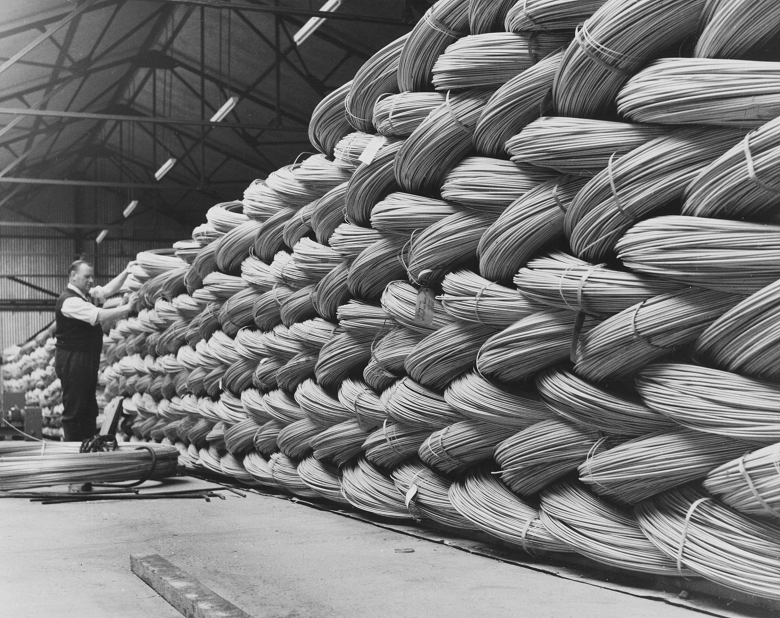
The first consignment of special steel wire is checked after arriving in South Queensferry. (© Newsquest, Herald & Times. Licensed via Scran)
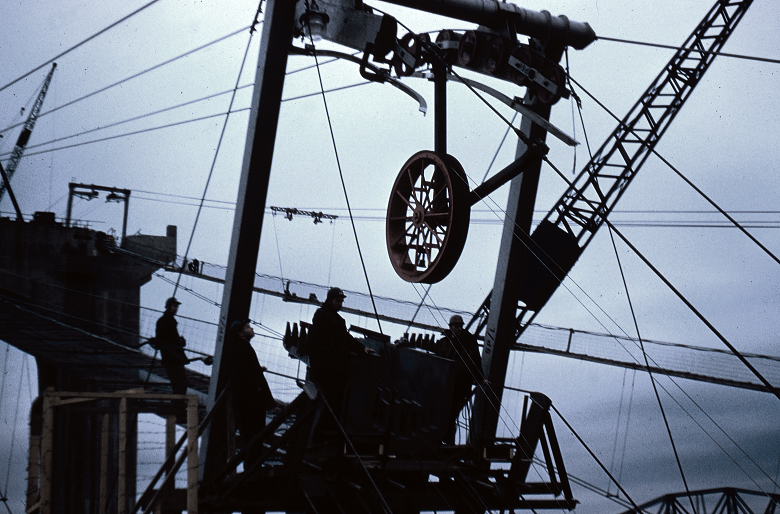
A spinning wheel in action in 1961 (© Courtesy of HES. RB Wood Collection. Zoom in on Canmore)
Construction begins on the Forth Road Bridge
With the cables in place, work began on building the roadway. It was built outwards from the towers, with careful calculations made to ensure the north and south sections met in the middle!
Five days before Christmas 1963, the two sections were joined.
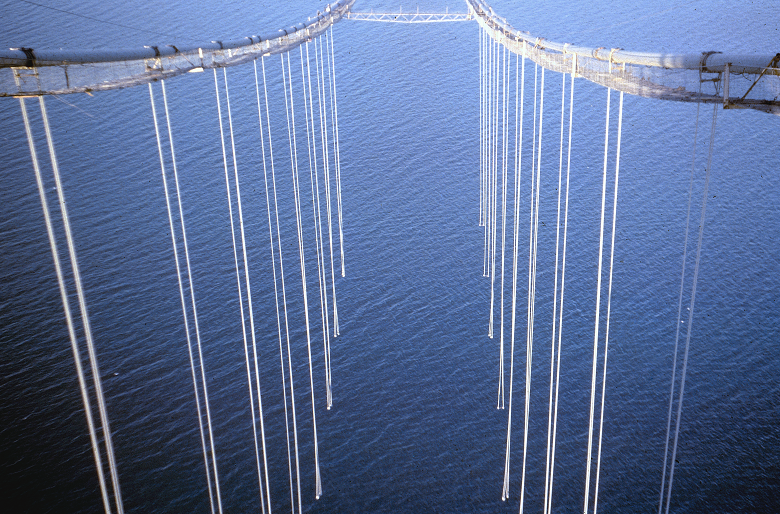
Long suspender ropes hanging from the Forth Road Bridge’s cables, ready for the addition of the roadway (© Courtesy of HES. RB Wood Collection. Zoom in on Canmore)
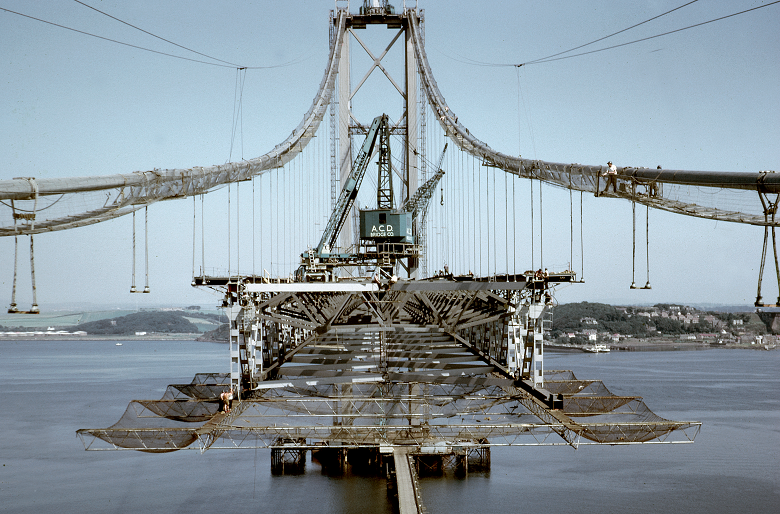
The north section of the bridge is edging closer in this photo taken from the south tower in June 1963. (© Courtesy of HES. RB Wood Collection. Zoom in on Canmore)
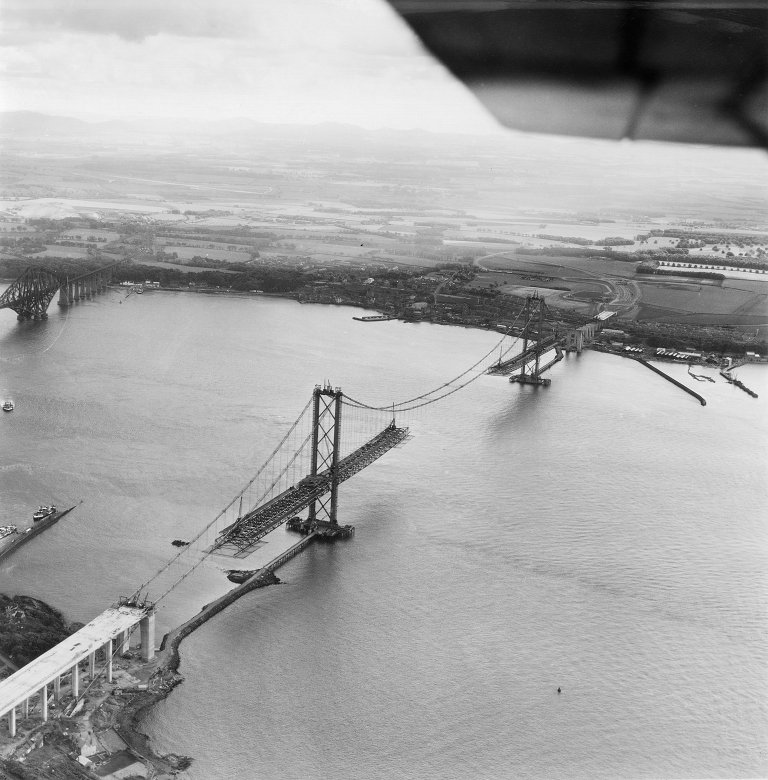
An aerial photo taken in June 1963 showing of the north and south sections of the Forth Road Bridge edging towards each other. (© HES, Aerofilms Collection. Zoom in on Canmore)
Grand opening
The Forth Road Bridge was designed to be able to withstand the turbulent and ever-changing Scottish weather, so it’s perhaps fitting the 4 September 1964 was a particularly dreich day.
The fog on the Forth was so thick that the brand new bridge couldn’t actually be seen from the riverside!
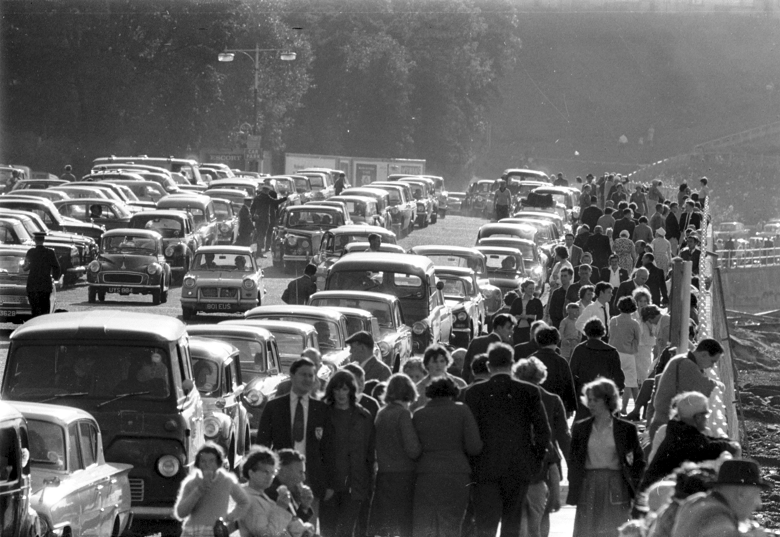
Crowds gather in South Queensferry to see the opening of the Forth Road Bridge on 4 September 1964 (© The Scotsman Publications Ltd. Licensed via Scran)
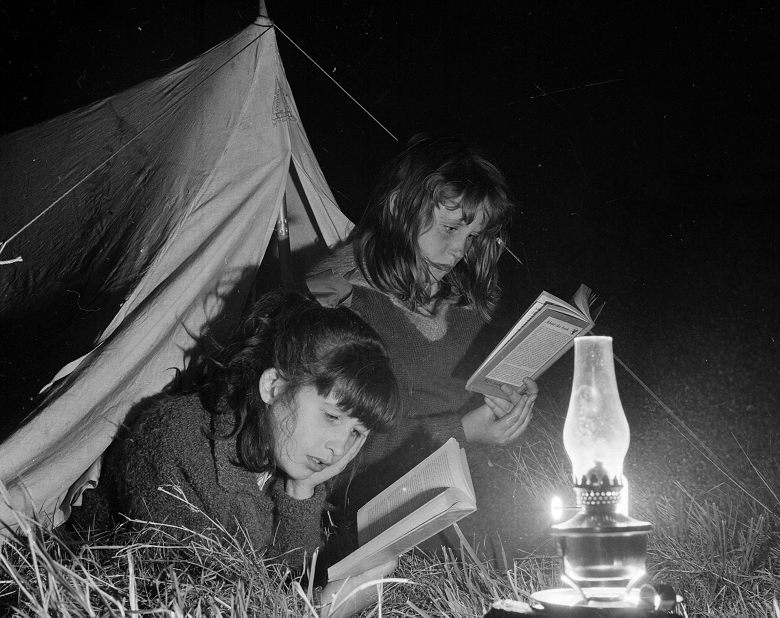
Muriel and Laura King camped overnight to ensure they witnessed the grand opening (© The Scotsman Publications Ltd. Licensed via Scran)
Thankfully, the weather improved just in time for Queen Elizabeth II and the Duke of Edinburgh to conduct the official opening. Thousands looked on as the Royals slowly drove across the bridge, joined, symbolically, by soldiers from Highland and Lowland regiments.
The Queen returned by boat, the last ever journey made by an 800-year-old ferry service now surplus to requirements.
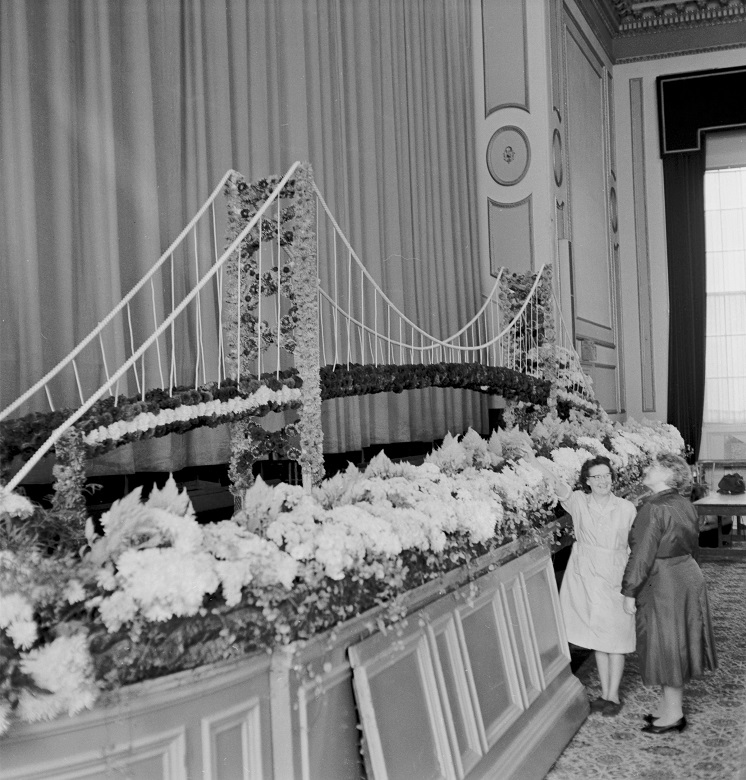
A floral tribute created for the opening of the Forth Road Bridge (© The Scotsman Publications Ltd. Licensed via Scran)
Milestones and maintenance
2.5 million vehicles crossed the bridge in its first year of operation. By 2002, the bridge had carried 250 million vehicles. The previous year it had received Category A listed status as “a landmark structure in post-war Scotland and “a continuation of the tradition of innovative Scottish engineering feats.”
A laser light display celebrated the 25th anniversary of the opening of the bridge in 1989. But it wouldn’t be too long before celebrations turned into concerns.
In 1990, the bridge was strengthened to deal with increasing amounts of traffic, before the 768 hanger ropes were replaced between 1998 and 2000. As Scotland entered the new millennium, concerns began rise about the condition and the future of the bridge.
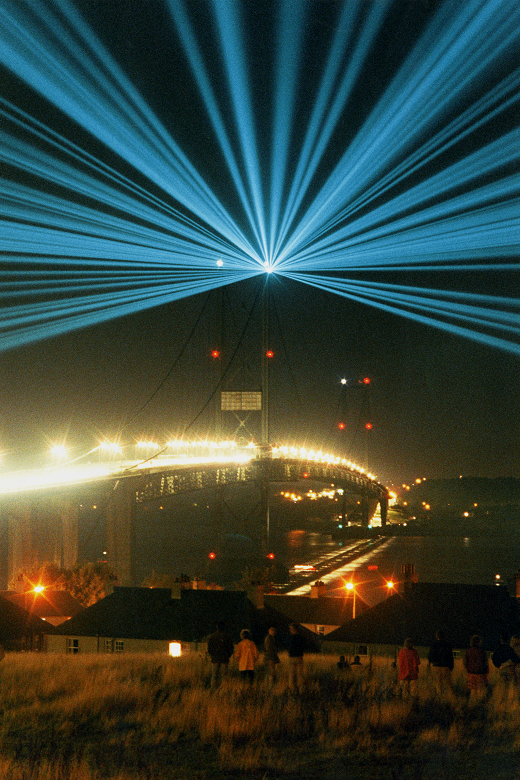
A grand laser display marked 25 years of the Forth Road Bridge (© Newsquest, Herald & Times. Licensed via Scran)
A new chapter in the story of the Forth crossings began in 2007, when it was decided a replacement bridge would be built. The Queensferry Crossing was officially opened, again by Queen Elizabeth II, on 4 September 2017, exactly 53 years after the ribbon was cut on its near neighbour.
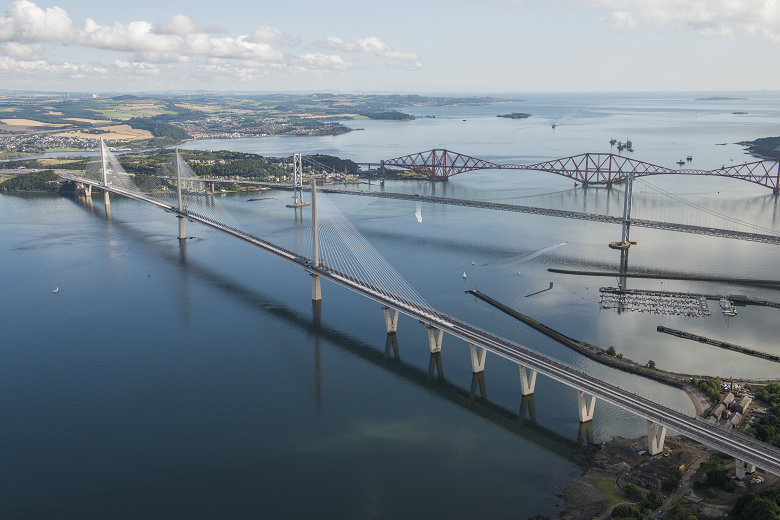
First, second, third, and Forth. The three Forth bridges. (© Crown Copyright: HES)
The Forth Road Bridge continues to carry travellers as a designated Public Transport Corridor. Some of them ride on another impressive feat of engineering – driverless buses!
You can find out more about joining the 60th anniversary celebrations on The Forth Bridges website. To combine views of the bridge with some memorising monastic history, why not sail to Inchcolm Abbey?

The Forth Road Bridge at sunset (© James Gardiner. Licensed via Scran)

